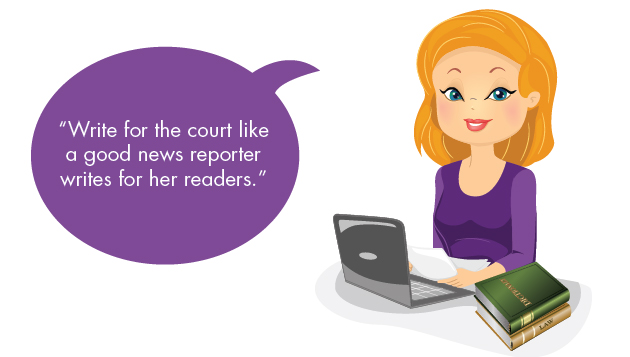 Editor’s note: We are excited to welcome attorney/researcher/writer Savannah Blackwell as she takes over the Legal Writing Tips Column.
Editor’s note: We are excited to welcome attorney/researcher/writer Savannah Blackwell as she takes over the Legal Writing Tips Column.
Write for the court like a good news reporter writes for her readers. A reporter attempts to answer all the basic questions about an event (who, what, where, when, why and how) in the opening of the article – or, in journalism jargon, the “lede.”
She puts the point of the story at or near the top. A lawyer should do the same in a brief, and for the same reason: Attention spans are short. The goal is to get the judge to consider the best argument before the inevitable interruption occurs and the brief is set aside.
All good news writers and novelists understand the importance of “hooking” the reader. Dickens, for example, did it by evoking an era: “It was the best of times, it was the worst of times….” A lawyer’s lede should direct attention to the main issue in the case.
Let the court know up front what it should focus on. Identify early on the standard of review for each issue, and then analyze each issue under the corresponding standard. Frequently, in appellant briefs, litigants analyze the issues as if the standard of review were de novo, and then throw in the proper standard as an afterthought. To increase the amount of time the court can devote to the issue that could be a winner, avoid raising issues sure to lose under the applicable standard of review.
Most cases turn on one key issue. Stick to that issue. At most, a brief should raise three issues. When judges look at briefs raising numerous issues, their first thought tends to be that none have any real merit. So get to the point — quickly. The shorter the brief, the more likely the court will read it.
The statement of facts section should read like a story – one comprising a thorough and accurate recitation of the record. Be precise and honest – scrupulously honest. Do not refer to matters outside the record. Support facts conveyed in each sentence with a citation to the exact line and page in the transcript or affidavit. Do not cite to a witness’s entire testimony. Woo the law clerks who typically read these filings and recommend outcomes to the court by sparing them from having to sift through the record to determine the basis for an asserted fact, or worse, leaving them free to assume none exists.
Finally, do not ignore a fact not in your client’s favor – especially one the other side is not likely to miss. “Draw the poison,” as they say, by presenting the unfavorable fact as positively as can be done credibly. Otherwise, your opponent’s spin will determine the court’s first impression of the matter, which frequently becomes its last.
About the author:
Savannah Blackwell is a former news reporter who covered government and politics for more than a decade, mostly in San Francisco. She became a licensed California attorney in 2010 and specializes in legal research and writing. She can be reached at savannah.blackwell@gmail.com.


